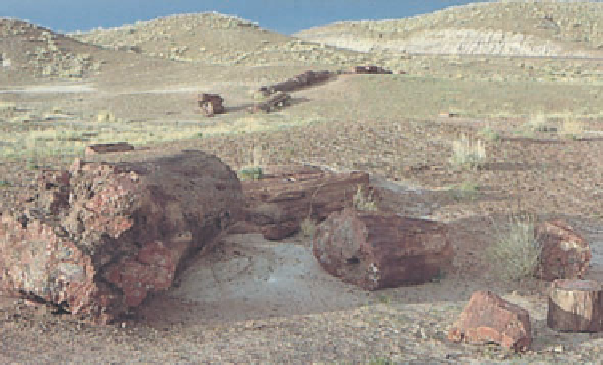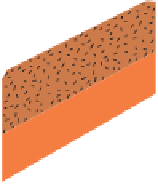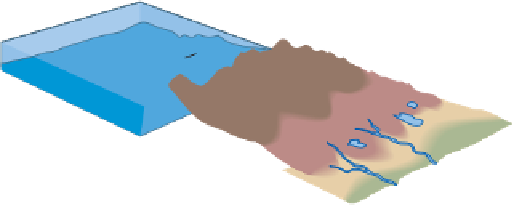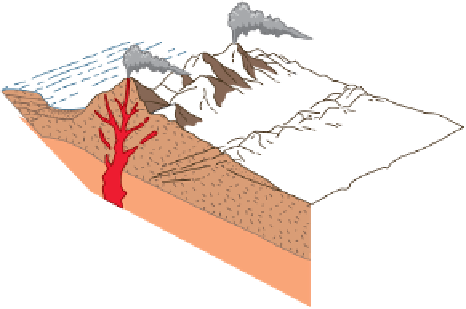Geology Reference
In-Depth Information
remains in sandstones that were deposited in
ancient stream channels.
As noted in Chapter 19, Proterozoic
banded iron formations are the main sources of
iron ores. There are, however, some important
exceptions. For example, the Jurassic-age “Mi-
nette” iron ores of Western Europe, composed
of oolitic limonite and hematite, are important
ores in France, Germany, Belgium, and Luxem-
bourg. In Great Britain, low-grade iron ores of
Jurassic age consist of oolitic siderite, which is
an iron carbonate. And in Spain, Cretaceous
rocks are the host rocks for iron minerals.
South Africa, the world's leading producer
of gem-quality diamonds and among the lead-
ers in industrial diamond production, mines
these minerals from kimberlite pipes, conical
igneous intrusions of dark gray or blue igneous
rock. Diamonds, which form at great depth
where pressure and temperature are high, are
brought to the surface during the explosive vol-
canism that forms kimberlite pipes. Although
kimberlite pipes have formed throughout geo-
logic time, the most intense episode of such
activity in South Africa and adjacent countries
was during the Cretaceous Period. Emplace-
ment of Triassic and Jurassic diamond-bearing
kimberlites also occured in Siberia.
In the Introduction we noted that the
mother lode or source for the placer deposits
mined during the California gold rush is in
Jurassic-age intrusive rocks of the Sierra Nevada.
Gold placers are also known in Cretaceous-age
conglomerates of the Klamath Mountains of
California and Oregon.
Porphyry copper was originally named for
copper deposits in the western United States
mined from porphyritic granodiorite; however,
◗
Figure 22.14
Sevier Orogeny
Great Valley Group
Sierra
Nevada
Franciscan
Complex
Sea level
Sevier
fold-thrust
belt
Continental
crust
Oceanic
crust
Melting
Upper mantle
a
The associated tectonic features of the Late Cretaceous Sevier orogeny,
caused by subduction of the Farallon plate under the North American plate.
Image not available due to copyright restrictions
these hydrocarbons are associated with structures
formed adjacent to rising salt domes. The salt,
called the
Louann Salt
, initially formed in a long
narrow sea when North America separated from
Europe and North Africa during the fragmenta-
tion of Pangaea (Figure 22.2)
The richest uranium ores in the United States
are widespread in Mesozoic rocks of the Colorado
Plateau area of Colorado and adjoining parts of
Wyoming, Utah, Arizona, and New Mexico. These
ores, consisting of fairly pure masses of a complex
potassium-, uranium-, and vanadium-bearing
mineral called
carnotite
, are associated with plant
◗
Figure 22.15
Petrifi ed Forest National Park, Arizona All of the logs here are
Araucarioxylon
, the most abundant tree in the park. The petrifi ed logs have been
weathered from the Chinle Formation and are mostly in the position in which
they were buried some 200 million years ago.








Search WWH ::

Custom Search